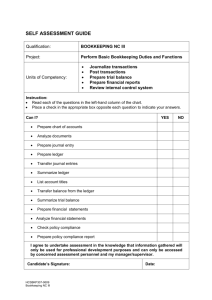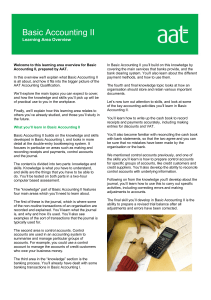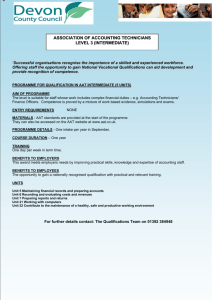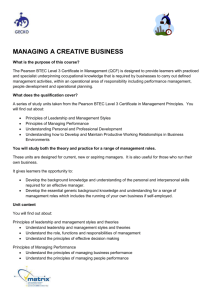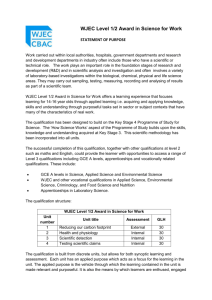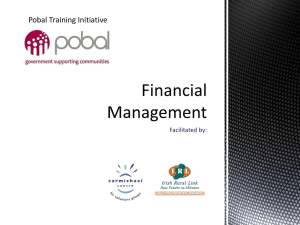AAT Level 2 Certificate in Accounting
advertisement
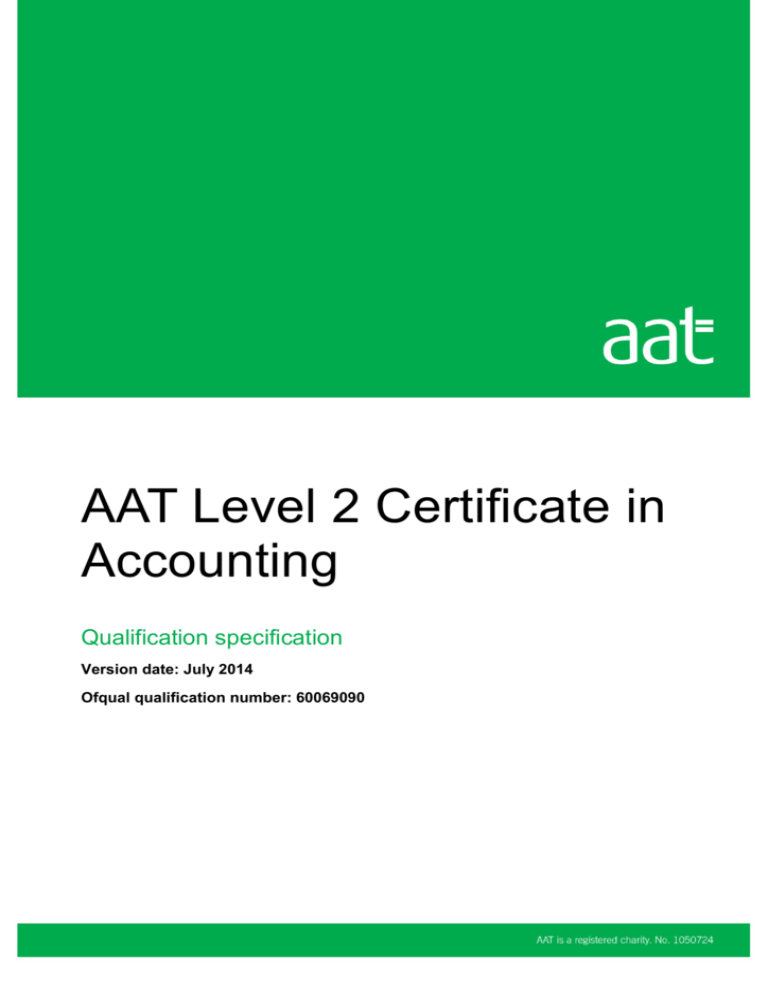
AAT Level 2 Certificate in Accounting Qualification specification Version date: July 2014 Ofqual qualification number: 60069090 1 Purpose statement Who is this qualification for? The AAT Level 2 Certificate in Accounting (QCF) is suitable for learners who are new to finance who wish to gain a thorough grounding in accountancy knowledge and skills from costing and double-entry bookkeeping to computerised accounting. It offers an excellent base for students to move directly into junior accountancy roles in business. The Level 2 Certificate is also included in the Intermediate Apprenticeship in Accounting and allows progression to higher levels of apprenticeship. Learners need no prior qualifications to complete this qualification. What does this qualification cover? The AAT Level 2 Certificate in Accounting (QCF) consists of 5 mandatory units (210 guided learning hours). On completion of this qualification students will be able to: use cost recording systems reflecting the income and expenditure of an organisation, comparing actual verses expected figures. communicate their findings using spreadsheets securely use a computerised accounting system, passwords and backup routines. understand ethical issues and sustainability understand the double entry bookkeeping system and associated processes understand the banking system process financial documents, maintain the journal and control accounts, reconcile balances and make corrections. What could this qualification lead to? This qualification equips learners with the skills they need to secure, and succeed in, junior accounting roles such as Accounts Assistant, Finance Assistant, Credit Control Assistant or Purchase Ledger Clerk. The AAT Level 2 Certificate is part of the full AAT suite of accountancy qualifications. Learners can begin their studies at Level 2 and progress through to the Level 4 Diploma in Accounting to become qualified Accounting Technicians and AAT members. AAT also offers the Level 2 Diploma in Accounting and Business at this level. The Level 2 Diploma includes additional units on study and employability skills to complete a full-year programme of study. For those students who already have these skills, the Certificate offers a more focused approach and may be completed in a shorter period. Will the qualification lead to further learning? The AAT Level 2 Certificate in Accounting is a component of the Intermediate Apprenticeship. Completion of the Level 2 qualification also allows for progression to the higher levels of the AAT Accounting Qualification (Level 3 and Level 4). 2 Who supports this qualification? This qualification is supported by CIPFA and the professional arm of AAT. In addition we have received support from the following employers: Futures for Children North Yorkshire County Council Hampshire County Council Birch Cooper Complete Bookkeeping Further information on the qualification, and supporting statements, can be found here. 3 The qualification at a glance What you’ll learn The Level 2 Certificate in Accounting is made up of five mandatory units, assessed by a mixture of computer based tests (CBT) and projects (CBP). Competency in all five units is required for award and certification of the Level 2 Certificate in Accounting. Qualification number: 60069090 Unit Unit title Level GLH QCF credit 1 Processing bookkeeping transactions 2 45 9 2 Control accounts, journals and the banking system 2 40 8 3 Basic costing 2 60 8 4 Work effectively in accounting and finance 2 40 5 5 Computerised accounting 2 25 4 210 34 Total Assessment method CBT 2 hours 10 tasks CBT 2 hours 12 tasks CBT 2 hours 17 tasks CBT 2 hours 11 tasks CBP 2 hours Assessment strategy CBT Students will normally be assessed by computer-based assessment and will be required to respond to CBT tasks in a variety of ways, for example using multiple choice, true/false, drag and drop, pick lists, text select, linking boxes, gapfill tools and AAT purpose built question types to reflect real workplace activities. CBP Assessment of this unit is via a computer based project, or workplace evidence, both of which are locally assessed by the training provider. AAT’s assessment will be based on a business organisation and comprise a series of tasks. Level 2 Assessment summary Achievement at Level 2 reflects the ability to select and use relevant knowledge, ideas, skills and procedures to complete well-defined tasks and address straightforward problems. It includes taking responsibility for completing tasks and procedures and exercising autonomy and judgement subject to overall direction or guidance. Knowledge and understanding Use understanding of facts, procedures and ideas to complete well-defined tasks and address straightforward problems Interpret relevant information and ideas Be aware of the types of information that are relevant to the area of study or work 4 Application and action Complete well-defined, generally routine tasks and address straightforward problems Select and use relevant skills and procedures Identify, gather and use relevant information to inform actions Identify how effective actions have been Autonomy and accountability Take responsibility for completing tasks and procedures Exercise autonomy and judgement subject to overall direction or guidance Title Processing bookkeeping transactions Level 2 GLH 45 Credit value 9 Unit reference number D/504/3974 Learning outcomes The learner will: Assessment criteria The learner can: 1 2 3 4 Understand the principles of processing financial transactions Understand the double entry bookkeeping system Understand discounts Prepare and process financial documentation for customers 1.1 Outline the purpose and content of these business documents: petty cash voucher invoice credit note remittance advice statement of account. 1.2 Explain the purpose and content of the books of prime entry. 1.3 List the ways in which customers may pay an organisation and an organisation may pay its suppliers 2.1 Explain the accounting equation and how it relates to a double entry bookkeeping system. 2.2 Outline how the books of prime entry integrate with the double entry bookkeeping system. 2.3 Describe the function of a coding system within a double entry bookkeeping system. 2.4 Describe the processing of financial transactions from the books of prime entry into the double entry bookkeeping system. 2.5 Define capital income and capital expenditure. 2.6 Define revenue income and revenue expenditure. 3.1 Describe default surcharge and the stages involved. 3.2 Determine whether a default surcharge applies and the penalty due. 4.1 Use source documents to prepare invoices or credit notes 4.2 Calculate invoice or credit note amounts reflecting any: trade discount bulk discount settlement discount sales tax 4.3 Enter sales invoices and credit notes into books of prime entry using suitable codes 5 5 6 7 8 Process supplier invoices and credit notes and calculate payments Maintain the cash book Maintain petty cash records Process ledger transactions and extract a trial balance 4.4 Check the accuracy of receipts from customers against relevant supporting documentation 4.5 Produce statements of account to send to credit customers 5.1 Check accuracy of supplier invoices and credit notes against these source documents: purchase orders goods received notes delivery notes. 5.2 Enter supplier invoices and credit notes into books of prime entry using suitable codes. 5.3 Reconcile supplier statements to purchase ledger accounts. 5.4 Calculate payments due to suppliers. 6.1 Enter receipts and payment details from relevant primary records into a three column analysed cashbook. 6.2 Total and balance the cashbook. 7.1 Enter petty cash transactions into an analysed petty cash book, accounting for tax where appropriate. 7.2 Total and balance the petty cash book. 7.3 Reconcile the petty cash book with the cash in hand. 7.4 Enter the reimbursement of the petty cash expenditure in the petty cash book using the imprest system. 8.1 Transfer data from the books of prime entry to the ledgers. 8.2 Total and balance ledger accounts, clearly showing balances carried down and brought down. 8.3 Extract an initial trial balance. Unit aim(s) Learners will be able to understand the double entry bookkeeping system and associated processes. Learners will be able to process financial documents into books of prime entry and ledger accounts, and produce an initial trial balance. 6 Title Control accounts, journals and the banking system Level 2 GLH 40 Credit value 8 Unit reference number H/504/3975 Learning outcomes The learner will: Assessment criteria The learner can: 1 2 3 4 Understand the purpose and use of control accounts and journals Maintain and use control accounts Maintain and use the journal Reconcile a bank statement with the cash book 1.1 Describe the general purpose of control accounts. 1.2 Describe the specific purpose of the following control accounts: sales ledger purchase ledger tax (VAT). 1.3 Explain the importance of reconciling the sales and purchase ledger control accounts regularly. 1.4 Describe the purpose of an aged trade receivables analysis. 1.5 Explain the need to deal with discrepancies quickly and professionally. 1.6 Describe the reasons for maintaining the journal. 1.7 Explain the content and format of the journal. 1.8 Identify errors that are corrected through the journal. 2.1 Prepare these control accounts: sales ledger purchases ledger tax (VAT). 2.2 Reconcile sales and purchase ledger control accounts with the relevant ledgers. 2.3 Verify the balance on the tax control account. 3.1 Create journal entries to record these transactions: a new set of double entry bookkeeping records an irrecoverable debt written off wages and salaries. 3.2 Create journal entries to correct errors not disclosed by the trial balance. 3.3 Create journal entries to open a suspense account to balance the trial balance. 3.4 Create journal entries to correct errors disclosed by the trial balance and to clear the suspense account. 3.5 Record journal entries in the ledger accounts. 3.6 Redraft the trial balance following adjustments. 4.1 Identify differences between individual items on the bank statement and in the cashbook. 4.2 Update the cashbook from the bank statement. 4.3 Prepare a bank reconciliation statement. 7 5 6 Process supplier invoices and credit notes and calculate payments Understand retention and storage requirements relating to banking documents 5.1 Identify the main services offered by banks and building societies. 5.2 Explain when funds banked are cleared and available for use. 5.3 Identify other forms of payment: cash cheques credit cards debit cards automated payments. 5.4 Identify the information required to ensure the following payments are valid: cheque credit card debit card. 5.5 Describe procedures to ensure the security of receipts and payments. 5.6 Describe the effect that different forms of payment will have on an organisation’s bank balance. 6.1 Explain the importance of a formal document retention policy for an organisation. 6.2 Identify the different types of documents that should be stored securely. Unit aim(s) Learners will be able to maintain the journal and control accounts, reconcile balances and make corrections, and redraft the trial balance. They will also understand the banking system. Title Basic costing Level 2 GLH 60 Credit value 8 Unit reference number L/504/3971 Learning outcomes The learner will: Assessment criteria The learner can: 1 2 Understand the cost recording system within an organisation Be able to use the cost recording system to record or extract data 1.1 Explain the nature of an organisation’s business transactions in relation to its accounting systems. 1.2 Explain the purpose and structure of a costing system within an organisation. 1.3 Identify the relationship between the costing and accounting systems within an organisation. 1.4 Identify sources of income and expenditure information for historic, current and forecast periods. 1.5 Identify types of cost, profit and investment centres. 2.1 Explain how materials, labour and expenses are classified and recorded. 2.2 Explain different methods of coding data. 8 3 Be able to use spreadsheets to provide information on actual and budgeted income and expenditure 2.3 Classify and code cost information for materials, labour and expenses. 2.4 Classify different types of inventory as: raw materials part-finished goods (work in progress) finished goods. 2.5 Calculate inventory valuations and issues of inventory using these methods: first in first out (FIFO) last in first out (LIFO) weighted average. 2.6 Use these methods to calculate payments for labour: time rate piecework rate bonuses. 2.7 Explain the nature of expenses and distinguish between fixed, variable and semi-variable overheads. 2.8 Calculate the direct cost of a product or service. 3.1 Enter income and expenditure data into a spreadsheet. 3.2 Explain how spreadsheets can be used to present information on income and expenditure and to facilitate internal reporting. 3.3 Enter budgeted and actual data on income and expenditure into a spreadsheet to provide a comparison of the results and identify differences. 3.4 Use basic spreadsheet functions and formulas. 3.5 Format the spreadsheet to present data in a clear and unambiguous manner and in accordance with organisational requirements Unit aim(s) Learners will be able to use cost recording systems to prepare information relating to the income and expenditure of an organisation. They will be able to make comparisons and identify differences between actual and expected figures, and communicate their findings using spreadsheets. 9 Title Work effectively in accounting and finance Level 2 GLH 40 Credit value 5 Unit reference number Y/504/3973 Learning outcomes The learner will: Assessment criteria The learner can: 1 2 3 4 5 6 Understand the accounting or payroll function within an organisation 1.1 Explain the role of accountancy or payroll functions within an organisation. 1.2 Identify the contribution of those in accounting or payroll functions to maintaining the smooth running, solvency and legal compliance of an organisation. 1.3 Identify appropriate reporting lines within the working environment. 1.4 Identify organisational policies or procedures that affect the workplace. Be able to use a range of communication skills 2.1 Prepare information using effective numeracy and literacy skills. 2.2 Present information in these formats using organisational house styles/guidelines: business report letter email or memo. Work independently or as part of a team 3.1 Manage work to prioritise routine and non-routine tasks. 3.2 Identify the impact that the completion or non-completion of work can have on colleagues. 3.3 Explain how dissatisfaction can occur within a team and when it is appropriate to refer to a manager. Develop skills and knowledge to meet personal and organisational needs 4.1 Explain the importance of continuing professional development. 4.2 Identify appropriate activities to meet development needs and objectives. Understand ethical values and principles 5.1 Identify the fundamental principles of ethical behaviour. 5.2 Explain the importance of confidentiality. 5.3 Identify situations when a conflict of interest may arise. 6.1 Identify organisational initiatives which support sustainability. 6.2 Explain the benefits of sustainable initiatives on an organisation and the environment. Understand sustainable values Unit aim(s) Learners will be able to apply the skills of literacy and numeracy in their work and gain skills of self-management and time management. Learners will also gain an appreciation of ethical issues and sustainability. 10 Title Computerised accounting Level 2 GLH 25 Credit value 4 Unit reference number R/504/3972 Learning outcomes The learner will: Assessment criteria The learner can: 1 2 3 4 5 6 7 Enter accounting data at the beginning of an accounting period Record customer transactions Record supplier transactions Record and reconcile bank and cash transactions 1.1 Set up general ledger accounts, entering opening balances where appropriate. 1.2 Set up customer accounts, entering opening balances where appropriate. 1.3 Set up supplier accounts, entering opening balances where appropriate. 2.1 Process sales invoices and credit notes, accounting for VAT. 2.2 Allocate monies received from customers in partial or full payment of invoices and balances. 3.1 Process purchase invoices and credit notes, accounting for VAT. 3.2 Allocate monies paid to suppliers in full or partial settlement of invoices and balances. 4.1 Process receipts and payments for non-credit transactions. 4.2 Process recurring receipts and payments. 4.3 Process petty cash receipts and payments, accounting for VAT. 4.4 Perform a periodic bank reconciliation. Be able to use journals to enter accounting transactions 5.1 Process journals for accounting transactions. 5.2 Use the journal to correct errors. Produce reports 6.1 Produce these routine reports for customers and suppliers: day books account activity aged analysis statements or remittance advice notes. 6.2 Produce these routine reports from the general ledger: trial balance audit trail account activity. 7.1 Make a copy of accounting data using the backup function of the accounting software. 7.2 Use a software password to protect accounting information. Maintain the safety and security of data held in the computerised accounting system Unit aim(s) Learners will be able to use a computerised accounting system to enter accounting transactions, perform a reconciliation, correct errors and produce a range of reports. They will also be able to maintain the security of accounting information using passwords and backup routines. 11
